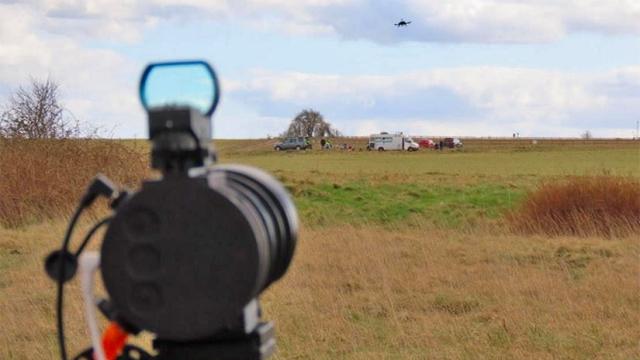The easiest way to knock a drone that poses a safety or security threat out of the sky is to hinder the wireless communications between the aircraft and those at its controls. But signal jammers that target radio frequency communications are useless against a new type of drone control system that uses laser beams instead.
As drones have become more adept at remotely delivering incendiary devices and even espionage, we’ve seen countless different ways developed to prevent them from completing their missions, including net-firing cannons, other drones that intercept and attack mid-flight by shooting off their own propellers, and even powerful lasers that can literally fry an airborne drone from miles away. But many of those systems also require complex detection devices that can identify and accurately track the movements of a drone. A much easier solution is to simply use signal jammers to disrupt communications between a drone and either its pilot or the satellites that let it steer autonomously.
But drone development is an ongoing cat and mouse game, and while anti-drone countermeasures are being developed, so are ways to circumvent those countermeasures. When it comes to signal jammers, a British company called QinetiQ has come up with a way to remotely operate drones without the use of radio signals, which can be disrupted and intercepted.
The new system leverages Free-Space Optical Communications (FSO, or FSOC), which trades radio signals for beams of light that are invisible and impossible to interfere with or intercept without physically placing a blockade or detector between the transmitter and the aircraft. QinetiQ has recently successfully tested a drone that uses lasers for a high-bandwidth line of communication between a drone and a ground station, which, with enough power, could offer a long range of remote operation.
There are some drawbacks to the approach. The communications can’t be remotely jammed, but they do have line of sight limitations, which means that if there’s an obstacle like a mountain between a pilot and the drone’s destination, the system wouldn’t work. The use of lasers also won’t help an autonomous drone dependent on GPS signals for navigation. It would still be able to securely beam back live videos or imagery using the high-bandwidth laser system, but would remain susceptible to signal jamming countermeasures. And while signal jamming is no longer a concern, countermeasures like a well aimed projectile are still very much a threat to the laser-controlled drone.
